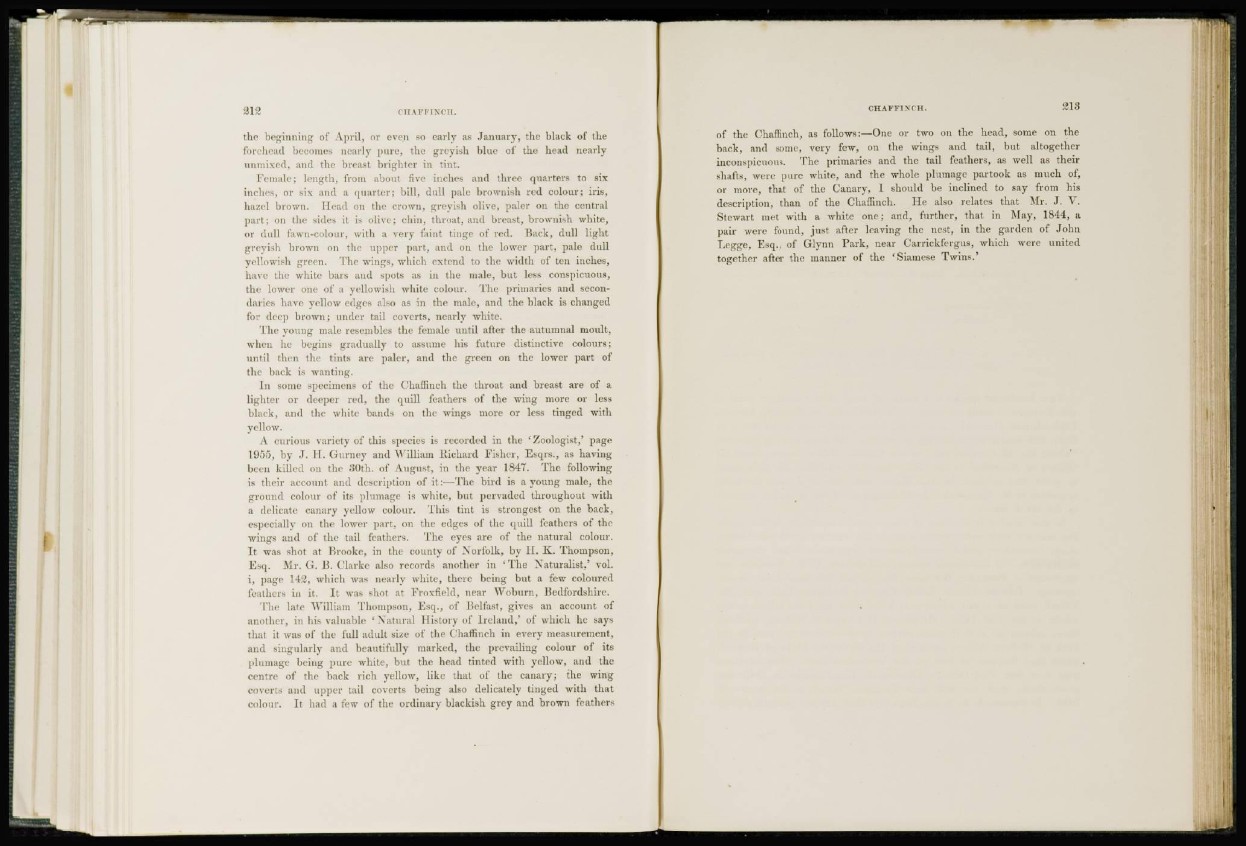
812 CHAFFINCH.
the beginning of April, or even so early as January, the black of the
forehead becomes nearly pure, the greyish, blue of the head nearly
unmixed, and the breast brighter in tint.
Female; length, from about five inches and three quarters to six
inches, or six and a quarter; bill, dull pale brownish red colour; iris,
hazel brown. Head on the crown, greyish olive, paler on the central
part; on the sides it is olive; chin, throat, and breast, brownish white,
or dull fawn-colour, with a very faint tinge of red. Back, dull light
greyish brown on the upper part, and on the lower part, pale dull
yellowish green. The wings, which extend to the width of ten inches,
have the white bars and spots as in the male, but less conspicuous,
the lower one of a yellowish white colour. The primaries and secondaries
have yellow edges also as in the male, and the black is changed
for deep brown; under tail coverts, nearly white.
The young male resembles the female until after the autumnal moult,
when he begins gradually to assume his future distinctive colours;
until then the tints are paler, and the green on the lower part of
the back is wanting.
In some specimens of the Chaffinch the throat and breast are of a
lighter or deeper red, the quill feathers of the wing more or less
black, and the white bands on the wings more or less tinged with
yellow.
A curious variety of this species is recorded in the 'Zoologist,' page
1955, by J. H. Gurney and William Richard Fisher, Esqrs., as having
been killed on the 30th. of August, in the year 1847. The following
is their account and description of it:—The bird is a young male, the
ground colour of its plumage is white, but pervaded throughout with
a delicate canary yellow colour. This tint is strongest on the back,
especially on the lower part, on the edges of the quill feathers of the
wings and of the tail feathers. The eyes are of the natural colour.
It was shot at Brooke, in the county of Norfolk, by II. K. Thompson,
Esq. Mr. G. B. Clarke also records another in 'The Naturalist,' vol.
i, page 142, which was nearly white, there being but a few coloured
feathers in it. It was shot at Froxfield, near Wobnrn, Bedfordshire.
The late William Thompson, Esq., of Belfast, gives an account of
another, in his valuable 'Natural History of Ireland,' of which he says
that it was of the full adult size of the Chaffinch in every measurement,
and singularly and beautifully marked, the prevailing colour of its
plumage being pure white, but the head tinted with yellow, and the
centre of the back rich yellow, like that of the canary; the wing
coverts ami upper tail coverts being also delicately tinged with that
colour. It had a few of the ordinary blackish grey and brown feathers
C H A F F I N C H . 213
of the Chaffinch, as follows:—One or two on the head, some on the
back, and some, very few, on the wings and tail, but altogether
inconspicuous. The primaries and the tail feathers, as well as their
shafts, were pure white, and the whole plumage partook as much of,
or more, that of the Canary, 1 should be inclined to say from his
description, than of the Chaffinch. He also relates that Mr. J. V.
Stewart met with a white one; and, further, that in May, 1844, a
pair were found, just after leaving the nest, in the garden of John
Legge, Esq., of Glynn Park, near Oarrickfergus, which were united
together after the manner of the 'Siamese Twins.'